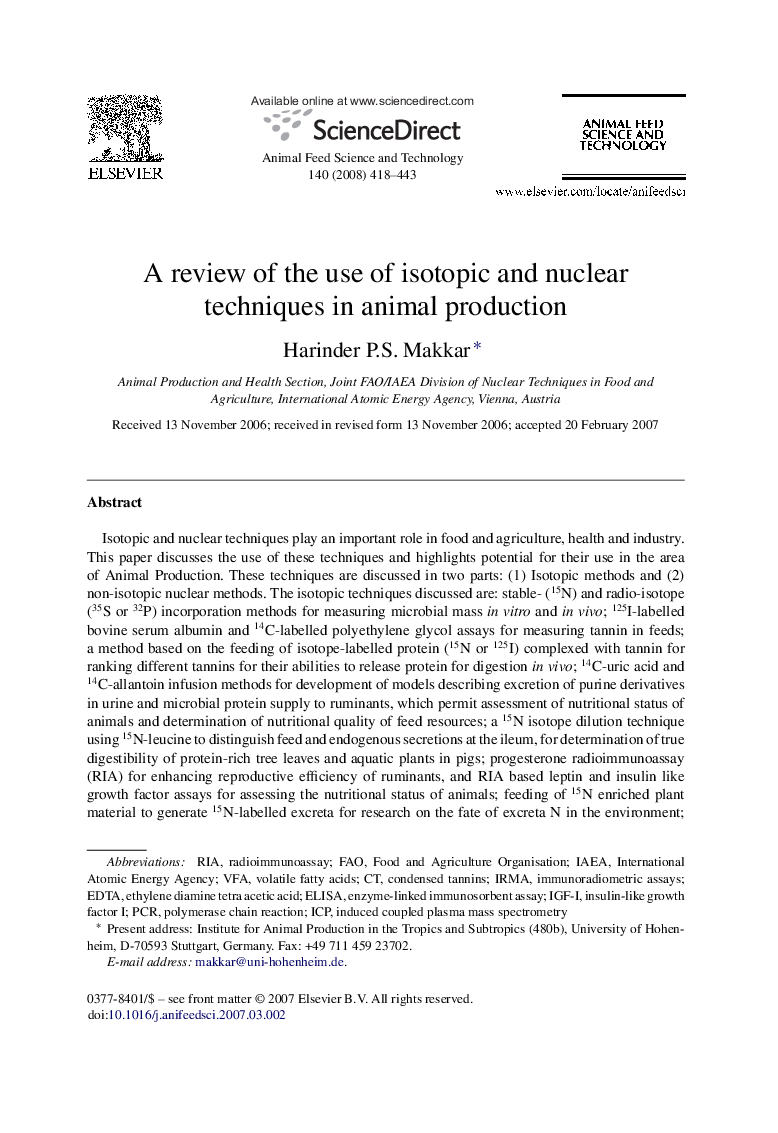| کد مقاله | کد نشریه | سال انتشار | مقاله انگلیسی | نسخه تمام متن |
|---|---|---|---|---|
| 2420750 | 1552475 | 2008 | 26 صفحه PDF | دانلود رایگان |

Isotopic and nuclear techniques play an important role in food and agriculture, health and industry. This paper discusses the use of these techniques and highlights potential for their use in the area of Animal Production. These techniques are discussed in two parts: (1) Isotopic methods and (2) non-isotopic nuclear methods. The isotopic techniques discussed are: stable- (15N) and radio-isotope (35S or 32P) incorporation methods for measuring microbial mass in vitro and in vivo; 125I-labelled bovine serum albumin and 14C-labelled polyethylene glycol assays for measuring tannin in feeds; a method based on the feeding of isotope-labelled protein (15N or 125I) complexed with tannin for ranking different tannins for their abilities to release protein for digestion in vivo; 14C-uric acid and 14C-allantoin infusion methods for development of models describing excretion of purine derivatives in urine and microbial protein supply to ruminants, which permit assessment of nutritional status of animals and determination of nutritional quality of feed resources; a 15N isotope dilution technique using 15N-leucine to distinguish feed and endogenous secretions at the ileum, for determination of true digestibility of protein-rich tree leaves and aquatic plants in pigs; progesterone radioimmunoassay (RIA) for enhancing reproductive efficiency of ruminants, and RIA based leptin and insulin like growth factor assays for assessing the nutritional status of animals; feeding of 15N enriched plant material to generate 15N-labelled excreta for research on the fate of excreta N in the environment; 15N, 13C and 34S isotopic methods for nutrient budgeting and for following the nutrient pathways in the soil–plant–animal continuum; 32P- or 33P-labelled fertilizers for estimating the efficiency of P utilization in legume leaf production used for livestock feeding; double labelled water (18O and 2H labelled) method for estimating energy expenditures of grazing animals, body composition, basal metabolic rate, and milk output in cows with calves; NaH13CO3/NaH14CO3 infusion for estimation of the carbon dioxide production, which in turn is used to estimate energy expenditure in free-ranging animals; 3H- or 14C-labelled methane and 14C-labelled volatile fatty acids dilution technique for direct and indirect (using stoichiometry of carbohydrate fermentation) for determination of methane emission from livestock; 15N dilution technique requiring labeling the soil with 15N fertilizer (15N-ammonium sulphate or 15N-urea) for estimation of nitrogen fixation by leguminous trees and pastures.The non-isotopic nuclear techniques that have been used or have the potential for use are: dual energy X-ray absorptionmetry and computer tomography for body composition determination; nuclear magnetic resonance techniques, fast atom bombardment mass spectroscopy, and mass ionisation spectroscopy for identification and structure determination of bioactive moieties of plant origin having potential for rumen manipulation or controlling internal parasites; gamma irradiation for inactivating antinutrients such as protease inhibitors, lectin, phytic acid, non-starch polysaccharides and oligosaccharides in feeds; induced mutations with gamma radiation, electron beam and fast neutrons for producing useful mutants of forage plants with improved yield, nutrient profiles and uptake.
Journal: Animal Feed Science and Technology - Volume 140, Issues 3–4, 15 January 2008, Pages 418–443